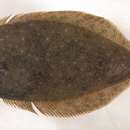Diagnostic Description
(
englanti
)
tarjonnut FAO species catalogs
Body elongated and deep. Mout large; maxillary extending beyond posterior margin of lower eye. Teeth on both jaws uniserial, strong and canine like. Interorbital flattish, its width about ½ of eye diameter. Scales very small; lateral line with 107-120 scales. Total gillrakers on first arch 6 + 15-18. Dorsal rays 77-81. Anal rays 59-61. Pectoral rays 12-13 (ocular side), middle rays branched on both sides. Vertebrae 11 + 27. Colour greyish or brownish, speckled and spoted with dark brown, the spots sometimes arranged in rings or half rings; body often with numerous small white spots; median fins mottled and spotted with darker; pectoral sometimes with irregular dark cross-bars.
Amaoka, K. - 1984 Paralichthyidae. In: H. Masuda; K. Amaoka; C. Araga; T. Uyeno; T. Yoshino (eds.). The Fishes of the Japanese Archipelago. Tokai. Univ. Press. 346-347.
Distribution
(
englanti
)
tarjonnut FAO species catalogs
Western Pacific Ocean from the Kuril Islands, Japan to the South China Sea.
Size
(
englanti
)
tarjonnut FAO species catalogs
Attains about 80 cm standard length.
Brief Summary
(
englanti
)
tarjonnut FAO species catalogs
Benthic, lives mainly on sandy bottoms,from a few meters to about 150 m.Feeds mainly on crustaceans, molluscs, worms and small fishes.
Benefits
(
englanti
)
tarjonnut FAO species catalogs
An important Japanese food-fish, which attains a large size. Most highly prized of the Japanese flounders. Caught with bottom trawls and other nets. The most common fishing techniques are "demersal bottom trawling" and "groundfish longlining". The total catch reported for this species to FAO for 1999 was 8 877 t. The countries with the largest catches were Japan (7 198 t) and Korea, Republic of (1 679 t).

